Line-crossing ceremony
This article needs additional citations for verification. (July 2016) |

The ceremony of Crossing the Line is an initiation rite in the British Merchant Navy, Dutch merchant navy, Royal Navy, U.S. Navy, U.S. Coast Guard, U.S. Marine Corps, Royal Australian Navy, Russian Navy, and other navies that commemorate a sailor's first crossing of the Equator.[1] The tradition may have originated with ceremonies when passing headlands, and become a "folly" sanctioned as a boost to morale,[2] or have been created as a test for seasoned sailors to ensure their new shipmates were capable of handling long rough times at sea. Sailors who have already crossed the Equator are nicknamed (Trusty/Honorable) Shellbacks, often referred to as Sons of Neptune; those who have not are nicknamed (Slimy) Pollywogs (in 1832 the nickname griffins was noted [3]).
Equator-crossing ceremonies, typically featuring King Neptune, are also sometimes carried out for passengers' entertainment on civilian ocean liners and cruise ships. They are also performed in the merchant navy and aboard sail training ships.
In the Western world
This article possibly contains original research. (September 2009) |


The two-day event (evening and day) is a ritual in which previously inducted crew members (Trusty Shellbacks) are organized into a "Court of Neptune" to induct the Slimy Pollywogs into "the mysteries of the Deep".[4] Physical hardship, in keeping with the spirit of the initiation, is tolerated, and each Pollywog is expected to endure a standard initiation rite in order to become a Shellback.[4] Depending on the Ocean or Fleet AOR, there can be variations in the rite. Some rites have discussed a role reversal as follows, but this is not always a normal feature, and may be dependent on whether a small number of Shellbacks exist to conduct the initiation.
The transition flows from established order to the controlled "chaos" of the Pollywog Revolt, the beginnings of re-order in the initiation rite as the fewer but experienced enlisted crew converts the Wogs through physical tests, then back to, and thereby affirming, the pre-established order of officers and enlisted.
The eve of the equatorial crossing is called Wog Day and, as with many other night-before rituals, is a mild type of reversal of the day to come. Wogs—all of the uninitiated—are allowed to capture and interrogate any shellbacks they can find (e.g., tying them up, cracking eggs or pouring aftershave lotion on their heads).[citation needed] The wogs are made very aware of the fact that it will be much harder on them if they do anything like this.
After crossing the line, Pollywogs receive subpoenas [5] to appear before King Neptune and his court (usually including his first assistant Davy Jones and her Highness Amphitrite and often various dignitaries, who are all represented by the highest ranking seamen), who officiate at the ceremony, which is often preceded by a beauty contest of men dressing up as women, each department of the ship being required to introduce one contestant in swimsuit drag. Afterwards, some wogs may be "interrogated" by King Neptune and his entourage, and the use of "truth serum" (hot sauce + after shave) and whole uncooked eggs put in the mouth. During the ceremony, the Pollywogs undergo a number of increasingly embarrassing ordeals (wearing clothing inside out and backwards; crawling on hands and knees on nonskid-coated decks; being swatted with short lengths of firehose; being locked in stocks and pillories and pelted with mushy fruit; being locked in a water coffin of salt-water and bright green sea dye (fluorescent sodium salt); crawling through chutes or large tubs of rotting garbage; kissing the Royal Baby's belly coated with axle grease, hair chopping, etc.), largely for the entertainment of the Shellbacks.

Once the ceremony is complete, a Pollywog receives a certificate [6] declaring his new status. Another rare status is the Golden Shellback, a person who has crossed the Equator at the 180th meridian (International Date Line). The rarest Shellback status is that of the Emerald Shellback (USA), or Royal Diamond Shellback (Commonwealth), which is received after crossing the Equator at the prime meridian.[7] When a ship must cross the Equator reasonably close to one of these meridians, the ship's captain will typically plot a course across the Golden X so that the ship's crew can be initiated as Golden or Emerald/Royal Diamond Shellbacks. [citation needed]

The University of Virginia's Semester at Sea Program holds a line-crossing ceremony twice a year for its students when their vessel, the MV Explorer (2001), crosses the equator.
Historical descriptions
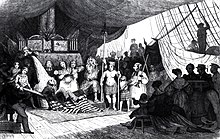
Captain Robert FitzRoy of HMS Beagle suggested the practice had developed from earlier ceremonies in Spanish, Portuguese, and Italian vessels passing notable headlands. He thought it was beneficial to morale: "The disagreeable practice alluded to has been permitted in most ships, because sanctioned by time; and though many condemn it as an absurd and dangerous piece of folly, it has also many advocates. Perhaps it is one of those amusements, of which the omission might be regretted. Its effects on the minds of those engaged in preparing for its mummeries, who enjoy it at the time, and talk of it long afterwards, cannot easily be judged of without being an eye-witness."
"Deep was the bath, to wash away all ill;
Notched was the razor—of bitter taste the pill.
Most ruffianly the barber looked—his comb was trebly nailed—
And water, dashed from every side, the neophyte assailed."
FitzRoy quoted Otto von Kotzebue's description:[2]
On the 11th of October [1823] we crossed the Equator at twenty-five degrees W. longitude, reckoning from Greenwich. Having saluted the Southern hemisphere by the firing of guns, our crew proceeded to enact the usual ceremonies. A sailor, who took pride in having frequently passed the Line, directed the performance with much solemnity and decorum. He appeared as Neptune, attired in a manner that was meant to be terribly imposing, accompanied by his consort, seated on a gun-carriage instead of a shell, drawn by negroes, as substitutes for Tritons. In the evening, the sailors represented, amidst general applause, a comedy of their own composition. These sports, while they serve to keep up the spirits of the men, and make them forget the difficulties they have to go through, produce also the most beneficial influence upon their health; a cheerful man being much more capable of resisting a fit of sickness than a melancholy one. It is the duty of commanders to use every innocent means of maintaining this temper in their crews; for in long voyages, when they are several months together wandering on an element not destined by nature for the residence of man, without enjoying even occasionally the recreations of the land, the mind naturally tends to melancholy, which of itself lays the foundation of many diseases, and sometimes even of insanity. Diversion is often the best medicine, and, used as a preservative, seldom fails of its effect." Otto von Kotzebue.[8]
There is a detailed account of the ceremony on board HMS Blossom in 1825 by Petty Officer John Bechervaise in his private publication Thirty-Six Years of a Sea Faring Life (1839), available from Kessinger in facsimile. Blossom was just starting a three-year voyage of exploration around the Horn to the Arctic.
There were on board the ship a great number of officers and seamen, who had never yet gone South of the Tropics, consequently were to be initiated into the mysteries of crossing the Equinoctial line, and entering the dominions of Neptune; great preparations had been making since our leaving Woolwich, for an event which promised to some part of the crew great amusement, to the other great fear; many a poor girl at Woolwich, and at Spithead had been deprived of some part of her wardrobe, to adorn Amphitrite; from one a night cap and gown had been stolen, from another some other part of dress, and although I had no hand in it, I was as bad as the rest, for I was consenting thereto. An immense grey horse hair wig, sufficiently long to reach well down the back of Neptune, had been purchased in England by subscription, accompanied by a venerable grey beard to sweep his aged breast; a tin crown and a trident completed the regalia. On a review of all those who previously had crossed the line, I was selected as Neptune; in vain I endeavoured to defend myself from being deified, it was useless, I must be Neptune, all remonstrance was vain; I took it, resolved to use the trident with mildness. Now reader fancy to yourself the writer of these lines with his legs and arms well blacked, his cheeks, vermillion, short and very loose trowsers, a double frilled shirt, from whose ample folds the salt water dripped plentifully, two swabs for epaulets, a long grey horse hair wig, a venerable beard of the same colour, a tin crown, a trident, and to complete the whole, a hoarse church yard cough; fancy all this I say, and Neptune, or your humble servant in his shape stands before you. The evening before we expected to cross the line, the lookout man reported at 8, P.M., a light a head; presently a hoarse voice hailed "ship ahoy" which being answered by the Captain, Neptune intimated his intention to visit the ship early next morning. Accordingly early in the morning the ship was made snug, the top-sails were close reefed, courses hauled up, top gallant sails furled, a new sail was secured to the gunwale of the barge on the booms, the other edge to the hammock netting, leaving a hollow of eight feet, capable of containing an immense quantity of water; into this sail the very men who were to be dipped in it, were employed in pumping and bailing water, little thinking, poor creatures, they were making a rod for themselves. A gun had been dismounted on the forecastle, the carriage made into a car, on which were to sit Neptune and Amphitrite, and between them the Triton; in order to keep all secret, a sail was run across the forecastle to screen Neptune and his gang from observation. Just before the appointed time, all who were likely to undergo the dreadful operation of shaving were ordered below, the gratings put on, and a constable stationed to prevent the ascent of more than one at a time; a wise regulation, for our numbers were nearly equal, and had they shown fight, might have conquered; a rope was rove through a block on the main yard arm, to one end of which was secured a handspike, astride of which sat a man with his hands fastened to the rope over his head.
...
The first of the ship's company that were shaved, who was brought up blindfolded by the whole posse of constables was the armourer, a weather-beaten honest old Hibernian, who had been a farrier in the Peninsular Army for many years. At the reduction, he had found his way as armourer of some small craft, and thence to our ship; on his entering for our ship, so anxious was he to be within the given age, which was thirty, that on being asked his age he gave it as eight and twenty, although fifty six was written in legible characters on his old cribbage face, which throughout the ship's company had gained him the cognomen of old eight and twenty. On this man then the barber had to perform his first functions; a bucket was filled with all the cleanings of the hen coops, pig-stys, &c. and with it a due proportion of tar had been mixed; with a large paint brush dipped in this villanous compound, and his razor, close to him the barber stood waiting the signal. My first question was "what is your name my man?" "John S----, your honour," at the instant of his opening his mouth the brush went across it, when the face the poor creature made it is impossible to describe, "phoo what do you call that?" "what do you call that?" I again asked the old man how old he was, "eight and twenty your honour, and so I am; oh I will spake no more, I will spake no more." As a last effort to make him open his mouth, I said if you mean to put him overboard, mind have a good rope round him for perhaps he cannot swim. Terrified at the idea of being thrown overboard the poor fellow said "I cannot swim, oh, I cannot swim;" but as the brush again crossed his mouth, he uttered with his teeth closed, "I will spake no more, by J---s I will spake no more if you drown me." Amid a roar of laughter two men tripped the handspike on which he sat and sent him backward into the sail where the bear was waiting to receive him; it was soon over, he escaped and stood by to see his shipmates share his fate. At the time of his being shaved he was not aware who Neptune was, when he found it out I could not get him to speak to me for some time; at length Irish good temper conquered, and we were friends again.
— John Bechervaise, Thirty-six Years of Seafaring Life p.146-150[9]
A similar ceremony took place during the second survey voyage of HMS Beagle. As they approached the equator on the evening of 16 February 1832, a pseudo-Neptune hailed the ship. Those credulous enough to run forward to see Neptune "were received with the watery honours which it is customary to bestow".[2] The officer on watch reported a boat ahead, and Captain FitzRoy ordered "hands up, shorten sail". Using a speaking trumpet he questioned Neptune, who would visit them the next morning. About 9am the next day, the novices or griffins were assembled in the darkness and heat of the lower deck, then one at a time were blindfolded and led up on deck by "four of Neptunes constables", as "buckets of water were thundered all around". The first "griffin" was Charles Darwin, who noted in his diary how he "was then placed on a plank, which could be easily tilted up into a large bath of water. — They then lathered my face & mouth with pitch and paint, & scraped some of it off with a piece of roughened iron hoop. —a signal being given I was tilted head over heels into the water, where two men received me & ducked me. —at last, glad enough, I escaped. — most of the others were treated much worse, dirty mixtures being put in their mouths & rubbed on their faces. — The whole ship was a shower bath: & water was flying about in every direction: of course not one person, even the Captain, got clear of being wet through." The ship's artist, Augustus Earle, made a sketch of the scene.[3]
U.S. President Franklin D. Roosevelt described his Crossing the Line ceremony aboard the "Happy Ship" USS Indianapolis with his "Jolly Companions" in a letter to his wife Eleanor Roosevelt on 26 November 1936:
Marvelous costumes in which King Neptune and Queen Aphrodite [sic.] and their court appeared. The Pollywogs were given an intensive initiation lasting two days, but we have all survived and are now full-fledged Shellbacks"
— FDR [10]
Controversy
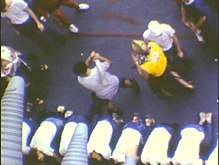

In the 19th century and earlier, the line-crossing ceremony was quite a brutal event, often involving beating pollywogs with boards and wet ropes and sometimes throwing the victims over the side of the ship, dragging the pollywog in the surf from the stern. In more than one instance, sailors were reported to have been killed while participating in a line-crossing ceremony.
As late as World War II, the line-crossing ceremony was still rather rough and involved activities such as the "Devil's Tongue", which was an electrified piece of metal poked into the sides of those deemed pollywogs. Beatings were often still common, usually with wet firehoses, and several World War II Navy deck logs speak of sailors visiting sick bay after crossing the line.
Efforts to curtail the line-crossing ceremony did not begin until the 1980s, when several reports of blatant hazing began to circulate regarding the line-crossing ceremony, and at least one death was attributed to abuse while crossing the line.[citation needed]
California Maritime Academy observed the line-crossing ceremony until 1989, after which the ceremony was deemed to be hazing and was forbidden. The 1989 crossing was fairly typical, as it was not realized to be the last one. Pollywogs participated voluntarily, though women midshipmen observed that they were under social pressure to do the ceremony but were targets of harder abuse.[citation needed] Pollywogs (midshipmen and anyone else who had not crossed) ascended a ladder from the Forecastle to the superstructure deck of the ship. There, they crawled down a gauntlet of shellbacks on both sides of a long, heavy canvas runner, about 10–12 meters. The shellbacks had prepared 3-foot, or 1-meter, lengths of canvas/rubber firehose, which they swung hard at the posterior of each wog. The wogs then ascended a ladder to the boatdeck to slide down a makeshift chute into the baptism of messdeck leavings in sea water in an inflated liferaft back on the superstructure deck. Wogs then returned to the forecastle, where they were hosed off by firehose and then allowed to kiss, in turn, the belly of the sea-baby, the foot of the sea-hag, and the ring of King Neptune, each personified by shellbacks.[citation needed]


In 1995, a notorious line-crossing ceremony took place on an Australian submarine, HMAS Onslow. Sailors undergoing the ceremony were physically and verbally abused before being subjected to an act called "sump on the rump", where a dark liquid was daubed over each sailor's anus and genitalia. One sailor was then sexually assaulted with a long stick before all sailors undergoing the ceremony were forced to jump overboard until permitted to climb back aboard the submarine. A videotape of the ceremony was obtained by the Nine Network and aired on Australian television. The television coverage provoked widespread criticism, especially when the videotape showed some of the submarine's officers watching the entire proceedings from the conning tower.[11][12]
Most navies have since then instituted regulations that prohibit physical attacks on sailors undergoing the line-crossing ceremony. In modern times, rather than a dreaded rite of initiation, the line crossing ceremony has become a popular tradition in the U.S. Navy and the U.S. Coast Guard. In the PBS documentary Carrier filmed in 2005 (Episode 7, "Rites of Passage"), a crossing-the-line ceremony on the USS Nimitz was extensively documented. The ceremony is carefully orchestrated by the ship's officers, with some enthusiastic sailors chafing at the degree to which harassment was disallowed.
Line-crossing ceremonies are also carried out on many merchant ships. However, without the oversight of military justice, they can often get out of hand and lead to the abuse and assault that occurred in line-crossing ceremonies of the past.
Equatorial baptism
Baptism on the line, also called equatorial baptism, is an initiation ritual sometimes performed as a ship crosses the Equator, involving water baptism of passengers or crew who have never crossed the Equator before.[13] The ceremony is sometimes explained as being an initiation into the court of King Neptune.
The ritual is the subject of a painting by Matthew Benedict named The Mariner's Baptism and of a 1961 book by Henning Henningsen named Crossing the Equator: Sailor's Baptism and Other Initiation Rites.[14]
Honors
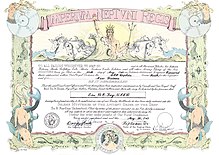
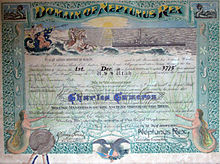

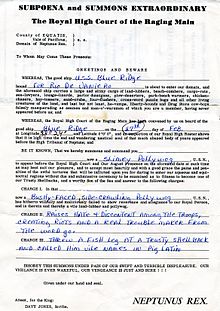
A popular patch has also been created for shellbacks that depicts Neptune battling a sea serpent with his trident.
This is the text from a certificate issued on a Royal Navy ship during the Second World War:
- A Proclamation
Whereas by our Royal Consension, Our Trusty, Well Beloved .................... has this day entered Our Domain. We do hereby declare to all whom it may concern that it is Our Royal Will and Pleasure to confer upon him the Freedom of the Seas without undue ceremony. Should he fall overboard, We do command that all Sharks, Dolphins, Whales, Mermaids and other dwellers in the Deep are to abstain from maltreating his person. And we further direct all Sailors, Soldiers, Airmen and others who have not crossed Our Royal Domain, to treat him with the respect due to One of Us. Given under Our Hand at Our Court on board H.M.S. .............. on the Equator in Longitude .....° on this ..... day of ..... in the year .....
(Signed)
Cancer — High Clerk
Neptune — Rex
This is the text from a certificate issued to United States Ships during World War II
Imperium Neptuni Regis
To all Shellbacks Greetings:
This is to Certify, that ..............
USS...............
was duly initiated into the Solemn Mysteries of the
Ancient Order of the Deep
And made a worthy Shellback in our Royal Dominion at Latitude 0000.
........,194-
Neptunus Rex
Ruler of the Raging Main
Official:
(Signed)
Commanding Officer, USS ...................
The certificate dipped in a bucket of ocean water and presented to the new trusty shellback.
This is the text from a certificate issued on a United States Navy ship during the 1960s:
Know ye, that .................... on the ..... day of ..... , aboard .............. appeared at the equator at Latitude .....° , Longitude .....° entering into Our Royal Domain, and having been inspected and found worthy by My Royal Staff and was initiated into the Solemn Mysteries of the Ancient Order of the Deep. I command my subjects to Honor and Respect him as one of our Trusty Shellbacks.
(Signed)
Davey Jones — His Royal Scribe
Neptunus Rex — Ruler of the Raging Main
The USS Franklin D. Roosevelt (CVA-42), under way to Rio de Janeiro, crossed the line on 4 July 1966, and its crew became known as "Star Spangled Shellbacks"; however, no previous mention of such honor has to date been located.
Submariners often become "Top Secret Shellbacks" having crossed the equator at a classified degree of longitude.
Similar "fraternities" in the navy include:
- The Order of the Blue Nose for maritime personnel who have crossed the Arctic Circle.
- The Order of the Red Nose for maritime personnel who have crossed the Antarctic Circle.
- The Imperial Order of the Golden Dragon for maritime personnel who have crossed the International Date Line.
- The Sacred Order Of The Golden Dragon for maritime personnel who have crossed at the same time Lat. 00-000°, Long. 180.00°
- The Order of the Ditch for maritime personnel who have passed through the Panama Canal.
- The Magellan's Strait Jacket Club for all maritime personnel who transited the Straits of Magellan.
- The Order of the Rock for maritime personnel who have transited the Strait of Gibraltar.
- The Safari to Suez for maritime personnel who have passed through the Suez Canal.
- The Golden Shellback for maritime personnel who have crossed the point where the Equator crosses the International Date Line.
- The Order of the Sand Squid for maritime personnel who have been attached to army units or stationed in the Middle East.
- The Emerald Shellback or Royal Diamond Shellback for maritime personnel who cross at 0 degrees off West Africa (where the Equator crosses the prime meridian)
- The Realm of the Czars for maritime personnel who crossed into the Black Sea.
- The Order of Magellan for maritime personnel who circumnavigated the Earth.
- The Order of the Lakes for maritime personnel who have sailed on all five Great Lakes.
- The Order of the Spanish Main for maritime personnel who have sailed in the Caribbean.
- The Order of the Sparrow for maritime personnel who sailed on all 7 seas. (North Atlantic, South Atlantic, North Pacific, South Pacific, Indian, Arctic, Antarctic Oceans)
- The Order of the Ebony Shellback for maritime personnel who have crossed the Equator on Lake Victoria.
- The Royal Order of Purple Porpoises for maritime personnel who crossed the junction of the Equator and the International Date Line at the Sacred Hour of the Vernal Equinox.
See also
Bibliography
- Simon J. Bronner, Crossing the line. Violence, play, and drama in naval equator traditions. Amsterdam: Amsterdam University Press, 2006 (= Meertens Ethnology Cahier no. 2).
References
- ^ Eyers, Jonathan (2011). Don't Shoot the Albatross!: Nautical Myths and Superstitions. A&C Black, London, UK. ISBN 978-1-4081-3131-2.
- ^ a b c Robert FitzRoy (1839) Narrative of the surveying voyages of His Majesty's Ships Adventure and Beagle between the years 1826 and 1836, London: Henry Colburn. pp. 57–58.
- ^ a b Keynes, R. D. ed. (2001) Charles Darwin's Beagle diary, Cambridge University Press, pp. 36–38.
- ^ a b Richardson, Keith P. (1 April 1977). "Western Folklore". 36 (2): 154–159.
{{cite journal}}: Cite journal requires|journal=(help) - ^ "Ceremonial Certificates - Neptune Subpoena". Usni.org. Retrieved 2013-11-18.
- ^ Ceremonial Certificates - Golden Shellback Certificate - Personalized
- ^ "Commemorative Certificates". History.navy.mil. Retrieved 2013-11-18.
- ^ Otto von Kotzebue (1830) A New Voyage Round the World, Henry Colburn and Richard Bentley, London: Project Gutenberg eBook.
- ^ "Thirty-six Years of Seafaring Life, digitized by Google". Books.google.com. Retrieved 2013-11-18.
- ^ Cook, Blanche (1999). Eleanor Roosevelt, vol. 2 (1933-1938). Penguin. p. 398. ISBN 978-0140178944.
{{cite book}}: Unknown parameter|city=ignored (|location=suggested) (help) - ^ The Australian Association of Maritime History newsletter, September 1999 Archived 2005-07-10 at the Wayback Machine
- ^ "Navy submarine hot bunking". Milism.net. 1993-06-22. Retrieved 2013-11-18.
- ^ Appleton, Victor (1916). "IX. The Bomb". Tom Swift and His Big Tunnel. Vol. 19. Grosset & Dunlap.
The Bellaconda "crossed the line," and there was the usual horseplay among the sailors when Father Neptune came aboard to hold court. Those who had never before been below the equator were made to undergo more or less of an initiation, being lathered and shaved, and then pushed backward into a canvas tank of water on deck.
- ^ Matthew Benedict - Crossing the Line Archived 2006-02-11 at the Wayback Machine
- ^ http://www.shortsnorter.org/Harry_Revers_Short_Snorter.html
External links
- Brief description of equatorial baptism
- Some accounts of baptism on the line:
- [1] - The Anti-Vacation
- [2] - Pust-Norden
- [3] - Greenpeace

